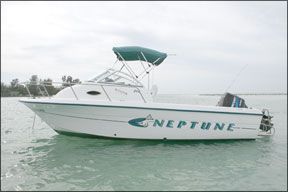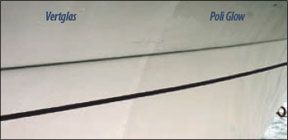At some point in the life of a cruising sailboat, hull wax or fiberglass polish is no longer an option and restoring gel coat requires more serious commitment. Hull restorers contain water-based emulsions of acrylic or acrylic/urethane resins. The resins are tiny droplets suspended in water. When applied the water evaporates, and the resins flow together to form clear films. The process is similar to what happens with many fiberglass or gel-coat finishes. For this Practical Sailor test, surface preparation was critical. If you miss a streak of dirt or grease, that blemish will become trapped under the hull restorer.
****

Some Practical Sailorreaders take meticulous care of their boats, faithfully cleaning and waxing their hulls to keep them in boat-show condition. But for most of us, life gets in the way, and the hull may be neglected for a season&emdash;or three. In fact, the gelcoat may be so far gone that even a good wax (we recommend Collinite 885, see Nov. 15, 2004 issue) might have a tough time bringing it back.
Enter the hull restorer. These products contain resins of higher molecular weight, which provide a harder and more durable film than what can be achieved with wax. Hull restorers contain water-based emulsions of acrylic or acrylic/urethane resins. The resins are tiny droplets suspended in water. When applied, the water evaporates and the droplets flow together to form clear films. These emulsions dry rapidly and require multiple coats.
In late 2003, we applied three hull restorers to our Neptune 212 (see above) test boat. We divided the hull into three sections, and each restorer was applied to the same section on both sides of the hull. Poli Glow was applied to the bow. Vertglas was used on the hull sides, amidships. And we coated the aft hull sides with New Glass 2.

We realize that different areas of the boat may have endured more of a beating from the sun than others. For instance, the flared sections of the bow are somewhat more protected from the sun than the flat sections of the hull sides. But in the last three years, every inch of the hull has endured its fair share of sun and weather, so we feel the test results are useful.
What We Found
We never expected any of the products to last for three years. They are supposed to be re-applied after one or two seasons. But we were pleasantly surprised when we inspected the boat this fall, discovering that one section&emdash;the bow&emdash;was still “shiny.” The Poli Glows acrylic sheen is still clinging to the gelcoat. It looks good.
The other sections, those coated with Vertglas and New Glass 2, need some help. The Vertglas sections are spotty. The clear coating has come off on some parts, and the parts where it remains have no visible shine. It appears that most of the New Glass 2 is gone as the stern sections are dull.
Vertglas and Poli Glow hull restorers have not changed since our 2003 test. They use the same formulas and their kits come with the same applicators. However, there have been big changes over at New Glass 2, according to new owner Thom Goff. The acrylic solids&emdash;the stuff that makes the hull shiny&emdash;have been upped by 10 percent; the applicator and the labeling and directions have been improved; and the company now offers a cleanser (Pre-Treat) to prep the area that will be restored. Pre-Treat can also remove previous acrylic coatings. Vertglas and Poli Glow also provide cleaner/removers.
Conclusions
Manufacturers of all three hull restorers make it clear that surface preparation is essential to their products success. This means that if you miss a streak of dirt or grease, that blemish will become trapped under the hull restorer. Fortunately, our tester did an excellent job cleaning the hull before application, so there is no spotting on the test boat.
Recommending Poli Glow is a no-brainer. Its still hanging around after baking in the Florida sun for three years. And as we reported in 2003, it comes with a wide variety of applicators, clear directions, and an effective cleanser. But the apparent improvements over at New Glass 2 call for another test.
Well take them all off and re-apply new versions of all three to the same hull sections.


































